Salt Marsh Study Explores Effects of Plant Sourcing, Genetics on Climate Change Resilience
Research along Connecticut coast uses “warming chambers” to heat plants to simulate the salt marsh environment in the coming decades
By Juanita Asapokhai
A coastal habitat teeming with wading birds, small fish, fiddler crabs, and more aquatic life. A “sink” for carbon absorbed from the atmosphere, lessening the effects of global warming. A shield for coastlines battered by harsh waters, and a buffer for coastal homes against storm damage.
These are some of the roles that salt marshes play within Long Island Sound’s ecosystem. Salt marshes, or tidal marshes, are defined in a CT Sea Grant manual as “the green belts and meadows we see between the upland and the tidal waters of the Sound’s bays, coves, and estuaries.” Globally, they are considered some of the most productive ecosystems on Earth, essential for the health of animals and protecting communities along the coast. But they are also under increasing threats from sea level rise and rising temperatures due to climate change. Motivated by these concerns, Dr. Sarah Crosby, a marine scientist and director of Director of Conservation and Policy at the Maritime Aquarium at Norwalk, is working with other scientists conducting research on how warming temperatures impact salt marsh grasses and what strategies can be developed to restore habitats to make them resilient to climate change. The research is being funded through the Long Island Sound Study Research Program.
For Crosby, who is working in a new position at the aquarium that has a focus on protecting Long Island Sound, resiliency is measured in terms of how successfully salt marshes in the region will withstand the increases and changes to its climate in the coming decades. It is demonstrated by maintaining, as she describes the salt marsh environment as: “their ability to continue to look like marshes and act like marshes under these changing conditions.”
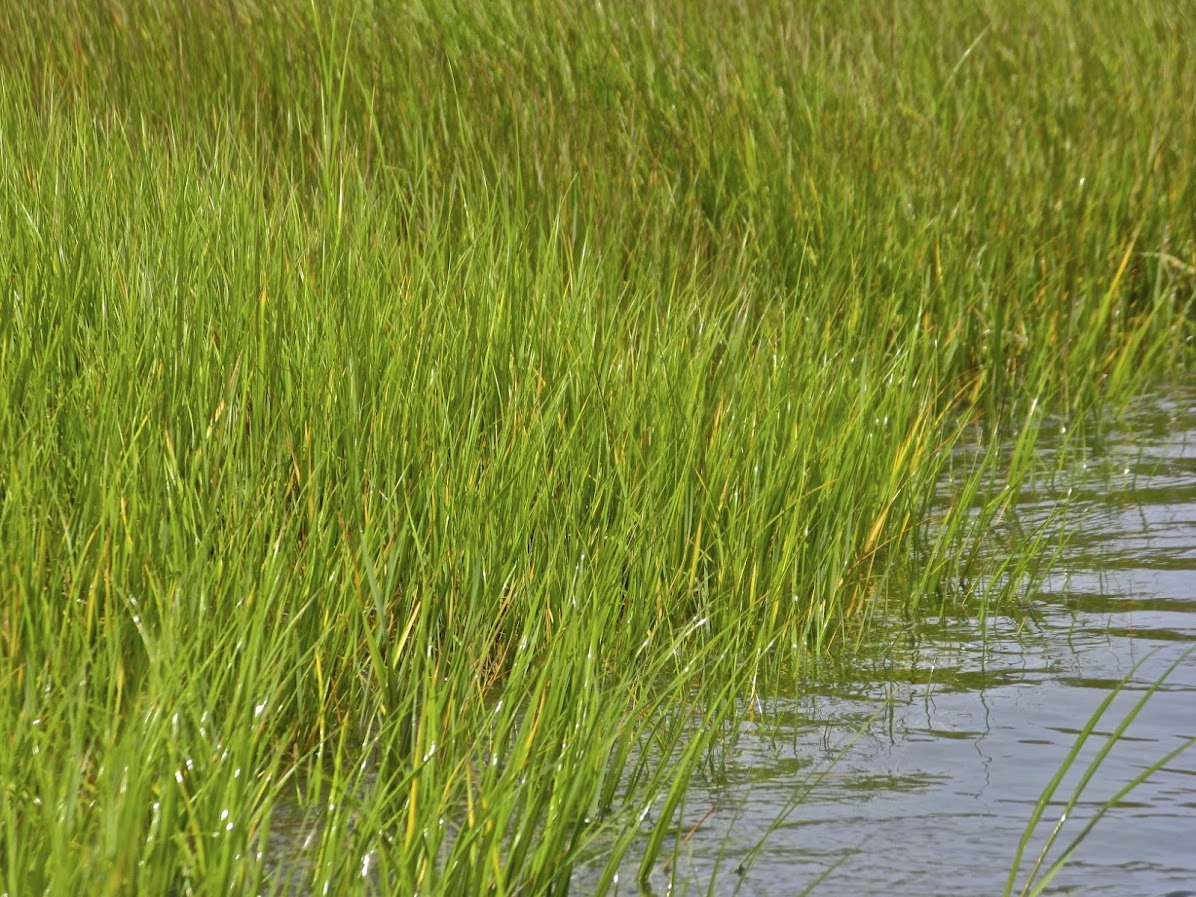
To gain a better understanding of climate resiliency, the research will investigate how long-term healthy marshes along Connecticut’s shore respond to projected temperature hikes compared to marshes that have been restored in the recent past. Secondly, it will look into whether, as temperatures rise, southern-sourced Spartina alterniflora, with genetic features and evolutionary history shaped by a warmer, southern climate, fare better than locally-sourced Spartina alterniflora, with the genetic features and evolutionary history suited to the northern climate.
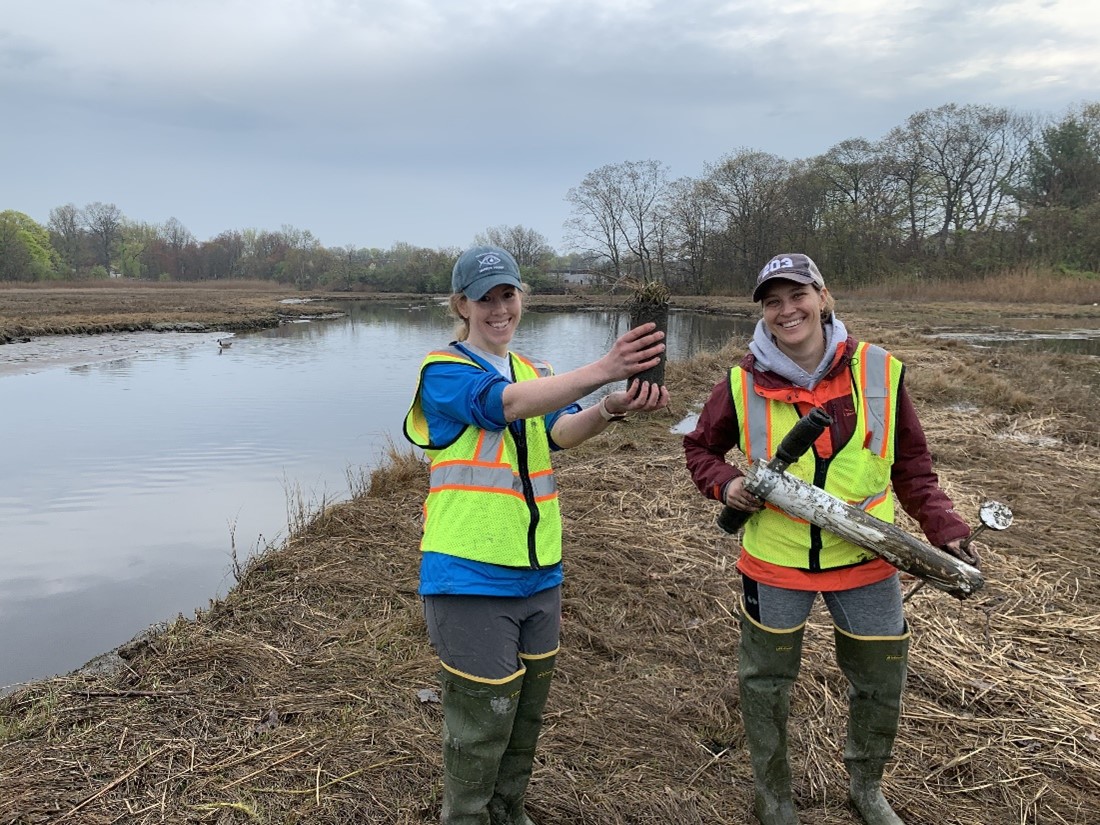
Spartina alterniflora, is the plant the research team, which besides Crosby includes Dr. LaTina Steele, an associate professor at Sacred Heart University, Dr. Randall Hughes, a professor at Northeastern University, and Nicole Spiller, the Director of Harbor Watch at Earthplace in Westport, CT is focused on. Also known as smooth cordgrass, the tall, slender grass inhabits the “low marsh,” the area of the salt marsh meadow closest to tidal waters where there is a daily occurrence of flooding. These grasses have a high tolerance for saltwater or brackish conditions. But in order to establish roots and survive in a wet and dry environment they are dependent on the buildup of sediment entering the marsh from daily tidal flow, as well as below ground biomass (from dead plants and organisms). The sediment and biomass must keep up with normal flooding and sea level rise. Any disruption to their habitat, such as increased sea level rise, can put their survival in jeopardy, and they will be forced to adapt, or die out.
Survival of the Fittest: Natural and Restored Marsh, Local-source and Southern-source Plants
To explore the potential effects of global warming on salt marsh plants, the research team selected eight sites across the Connecticut coast to observe and analyze Spartina alterniflora. Four of the sites are at long-established natural healthy marshes in the Sound: Oyster River and Gulf Pond located in Milford; the Bradford Preserve in East Haven; and Branford Harbor in Branford. The other four sites—the Great Meadows Marsh and Stratford Point in Stratford; the Housatonic River state boat launch in Milford; and the West River in West Haven—are restored marshes. Restored marshes are degraded marsh habitats that have been renewed by various managers and programs, including through the Long Island Sound Study’s Habitat Restoration Initiative.
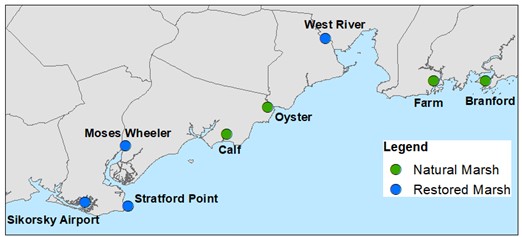
During the spring of 2023, the team assembled several enclosures called warming chambers at each of the sites to simulate what the temperatures would be like for the plants in the coming decades. Using PVC pipes to create a cube-shaped base structure, the team enclosed plots (small areas of vegetated habitat being measured by the researchers) of Spartina alterniflora within these open-top chambers. The chambers were made by wrapping the PVC base in thick, greenhouse-grade plastic sheeting on each side of the cube. On the top sheet of plastic sheeting, a hole is punctured in the center to permit precipitation into the plot. The grasses at restored marsh sites, planted within the last 10 years, will be compared to their natural marsh counterparts. Prior research on Connecticut marshes done by Crosby and her team has highlighted differences between natural and restored marsh. The study demonstrated that below ground biomass assembling under the surface of salt marshes is holding up better in natural marshes than in restored marshes. That being said, other findings also demonstrate that restored marshes have higher levels of genetic diversity, an advantage for a species facing imminent changes to the environment it is accustomed to, like rising temperatures.

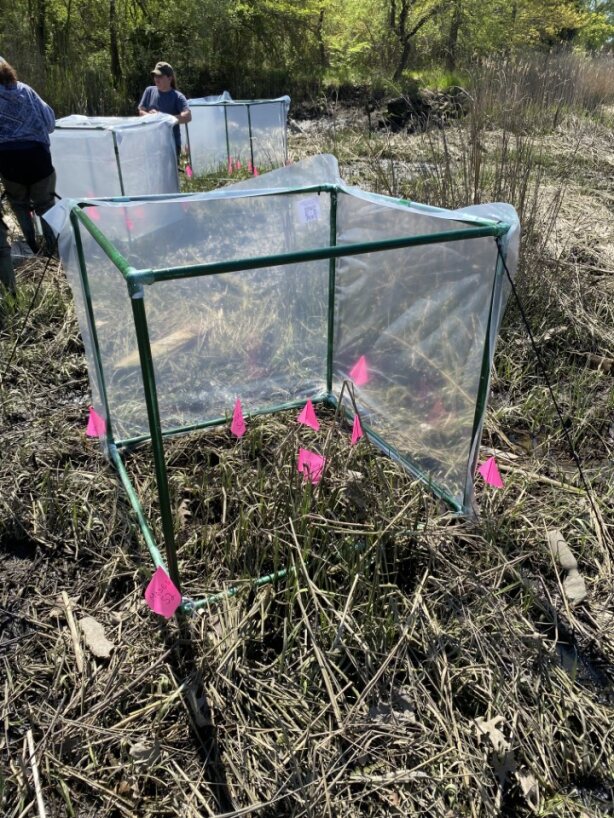
“You have a greater chance that one of those genotypes is well suited for the conditions that are about to happen,” said Crosby. Whether climate change warming will advantage one kind of marsh over another—and what methods or features can be adopted from one to use in another—will be explored using the data from the study.
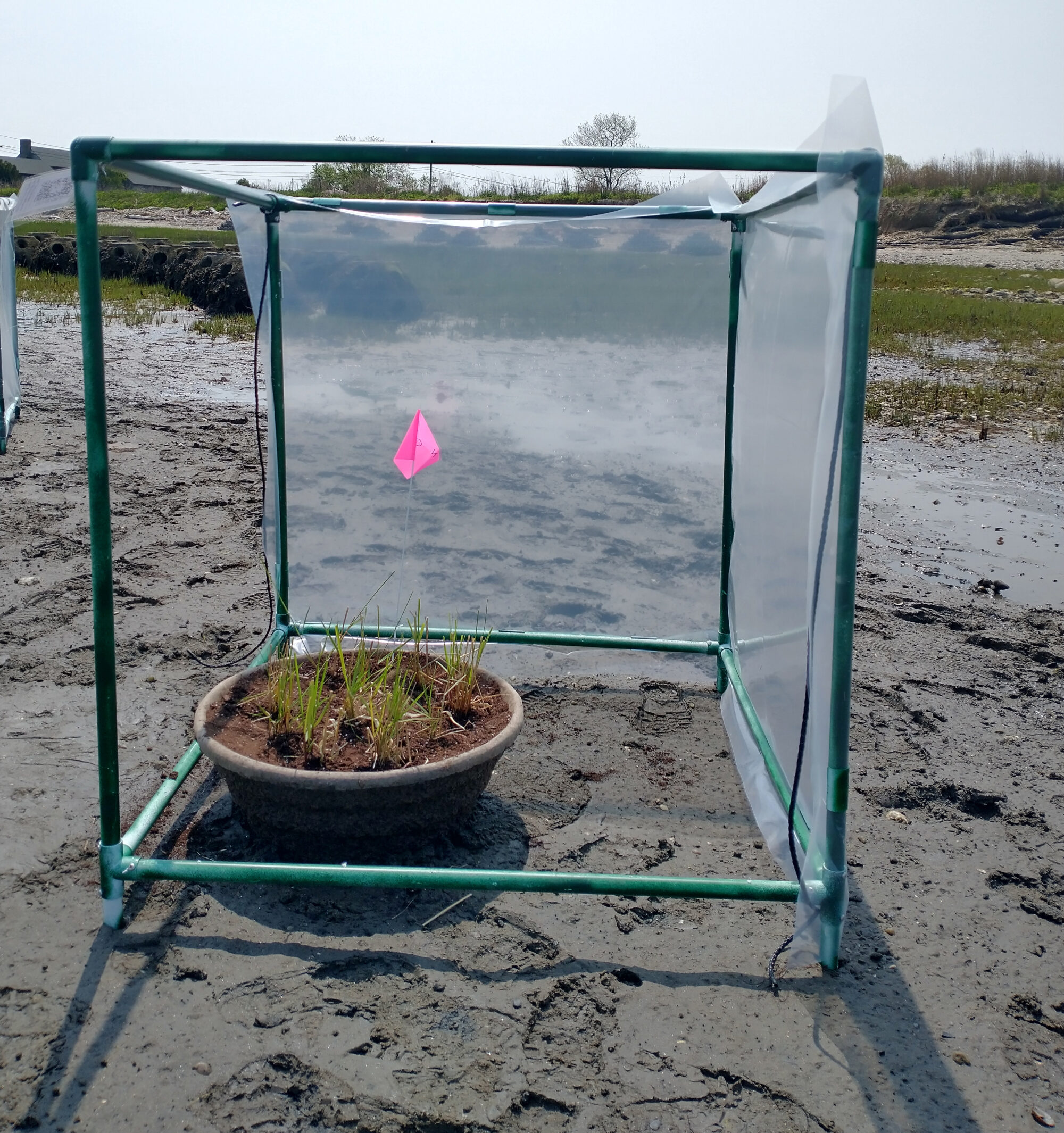
Set aside from the other seven locations, at the Stratford Point site, 18 experimental plantings were set up within the sand where Spartina alterniflora is growing, adjacent to the salt marshes. The research team has set these potted plants to house local, Connecticut-sourced plants as well as southern-source plants, in a combination of mixed and separate (i.e., local or southern-source only) plots. The potted plants will be used to observe differences in locally sourced and southern-sourced plants’ response to the heating temperatures. The southern-sourced plants, taken from nurseries in South Carolina and Florida, will be removed at the end of the study, to avoid unintended consequences related to introducing nonnative species to the Stratford Point marsh habitat.
The data collected from these experiments will provide information for Crosby and the rest of the research team to assess how global warming influences the growth of salt marshes, as well as its impact on their ability to store carbon. They are also interested in observing how the warming they simulate might change the allocation of biomass in a saltmarsh’s grasses—either increasing its biomass, decreasing it, or having no effects and maintaining the same amount of biomass pre-predicted global warming temperatures. According to Crosby, such effects are indicated by changes in the roots and stems of Spartina alterniflora, like their height, density, and diameter. “Some of those things may change because of some of the differences we see with latitude in these species, and how the plants grow slightly differently down south versus up here,” she said.
Biomass is just one characteristic that impacts the resilience of salt marsh plants, their capacity to endure significant changes to their environment.
“Not drowning under sea level rise; continuing to provide the habitat that we want them to; continuing to protect our soil from erosion,” said Crosby, listing some of the key and of resilience. The survival of the marsh at large ultimately hinges on the survival of the plants, like Spartina alterniflora, that they are founded on.
Gaming the Gene Pool: Exploring genetic adaptation to rising temperatures
As the investigators continue their work in the field, which will be ongoing through the fall of 2024, another segment of the project is taking place at a greenhouse and laboratory at Northeastern University in Boston. Led by geneticist Randall Hughes, researchers are studying the DNA of southern and locally-sourced plants to understand the role that genetics may play in the changing climate landscape for Spartina alterniflora and the marshes they grow.
The scientists are using DNA sequencing technology on leaf-tissue samples to examine the characteristics of the naturally growing healthy marshes, restored marshes, and plants sourced from northern and southern greenhouses to gain a better understanding of how genetic makeup favors or hinders their ability to survive under the temperatures anticipated in coming decades. They also hope to identify opportunities for breeding between local and southern-source plants that may increase adaptive potential, or resilience, through the production of offspring with the most “resilient set of genetics.” A question remains, however, about whether differences in the timing of flowering will prevent such mixing.
Fortifying Our Marshes
As the team continues the data collection phase of the project, Crosby expresses her hopes for the application of the findings of the study to boost the resilience of the Sound’s salt marshes and “translate into different management of these ecosystems.”
Salt marshes have an important, multifaceted identity in the Long Island Sound as habitats, carbon reservoirs, and natural protectors of shorelines and residential areas from increasingly destructive coastal storms. Crosby’s research helps to support the larger goal of Long Island Sound Study restoration efforts.
The goal is that the findings will reveal “whether there’s something we can do, that’s as simple as buying our plants from a different place that might actually make a difference,” said Crosby. “There’s a lot of potential applicable pieces of information that we’re hoping will come out of this.”
Juanita Asapokhai was a Communications Intern for the Long Island Sound Study in summer 2023. She attends Tufts University and will be graduating with degrees in Community Health and Sociology in the spring of 2024.